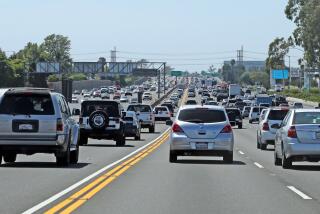Lawsuit Blames Rail Line in O.C. Crash
- Share via
Burlington Northern Santa Fe knew about the risks of a two-train crash but “consciously refused” to install safety systems that would have prevented last week’s deadly accident, according to a lawsuit filed Wednesday by the conductor of a Metrolink train hit by a BNSF freight.
Patrick Phillips suffered a brain hemorrhage in the head-on crash that killed two passengers and injured hundreds. The suit alleges that BNSF chose not to install an automatic braking system on its Southern California lines “simply to save money.”
The company declined to comment on the suit. The railroad industry--backed by federal regulators--has resisted installing the systems, saying the $3-billion estimated cost is too high and the technology is not refined enough to connect their entire networks.
The freight train engineer told authorities he was blinded by the sun and missed a yellow warning signal, failing to slow in time to stop at a red light. The automatic brake system includes a signal that applies brakes to trains when they hit warning lights. Officials from the National Transportation Safety Board called it a “worst-case scenario” crash--the kind they’ve been concerned about for years.
They also said an automatic braking system would have prevented the accident.
Phillips flew across the lead Metrolink car and suffered a brain hemorrhage, said his lawyer, Santa Monica attorney Larry R. Feldman. An MRI revealed blood on his brain, and he continues to suffer severe headaches and double vision, Feldman said.
The suit seeks compensatory and punitive damages to cover medical expenses, lost earnings and legal costs. But Feldman said he also hopes it prompts change.
“We’re going to try to have some good come out of this accident,” Feldman said. “You have a rail industry, including the [BNSF], that says this is a costly process and therefore... we are not going to put these safety devices on.
“The only conclusion that I think anyone can draw is that they’re saying it’s cheaper to pay for all these injured people and people who are killed or maimed than it is to put these devices on these tracks. It’s just ridiculous, and there’s no excuse for it.” The automatic braking system links passenger and freight trains to warning signals and triggers an automatic emergency stop if trains are on a collision course.
Only two rail lines in the United States use the braking systems: Amtrak lines in the Northeast and in Michigan. A pilot program testing the technology was conducted in Southern California and involved BNSF.
More to Read
Sign up for Essential California
The most important California stories and recommendations in your inbox every morning.
You may occasionally receive promotional content from the Los Angeles Times.











